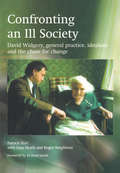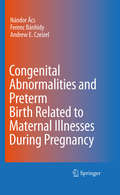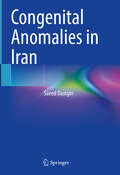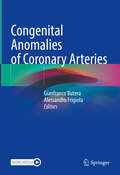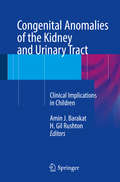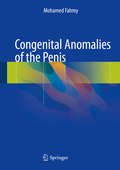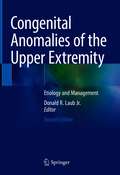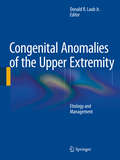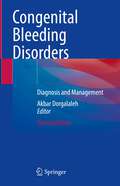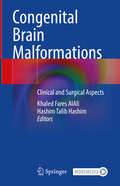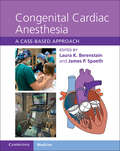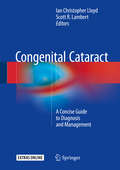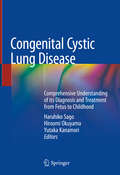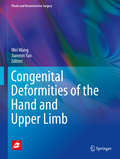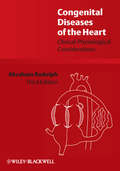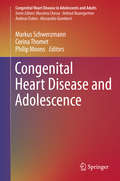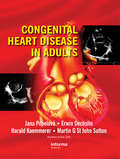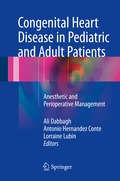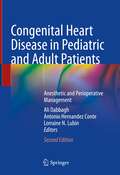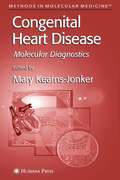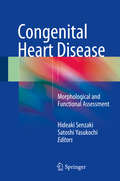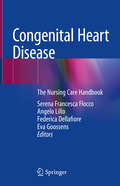- Table View
- List View
Confronting an Ill Society: David Widgery, General Practice, Idealism and the Chase for Change
by Iona Heath Roger Neighbour Patrick HuttIncreasing concern about clinical negligence demands the provision of more detailed patient information about the complications and risks of treatment and the agreement of patients to any intervention from a simple physical examination to the most complex surgical procedure. This concise practical guide provides doctors and nurses with the appropriate information needed to ensure that the patients have the knowledge to give informed consent. It identifies ways in which accusations of negligence can be minimised and includes explanations of the new NHS consent procedures that have recently being implemented. All healthcare professionals will find this book valuable reading.
Congenital Abnormalities and Preterm Birth Related to Maternal Illnesses During Pregnancy
by Andrew E. Czeizel Ferenc G. Bánhidy Nándor ÁcsThis book provides the analysis of a uniquely large, population-based data set evaluating congenital anomalies as a consequence of maternal diseases. The possible adverse birth outcomes of babies born to mothers diagnosed with important diseases have not yet been evaluated in such a material by the same method. The greatest merit of these studies is that by analyzing their data the authors managed to identify some new previously unknown associations between maternal diseases and adverse birth outcomes. The first aim of the authors was to summarize 50 years of experiences in human teratology which may help younger experts to use them. The second objective was to show the methodological weaknesses of previous studies and to recommend the use of up-to-date methods when designing new studies. A surveillance database like the one used in these studies effectively helps to monitor the most important indicators of adverse birth outcomes such as congenital anomalies, preterm births, and low birth weight, to evaluate the efficacy of medical care of pregnant women, and to detect possible causes of adverse birth outcomes in order to help in their prevention. In addition, the analysis of cost-benefit of this database showed that the benefit is much higher than cost. This book may be useful in the daily practice for obstetricians, paediatricians, general practitioners and epidemiologists, moreover it could be used in the training programmes of medical students and residents as well.
Congenital Anomalies in Iran
by Saeed DastgiriThis book explores the magnitude of the congenital anomalies and developmental disabilities based on the data from an established surveillance and prevention program of congenital defects, and describing the successful strategies for the control of neural tube defects, Down syndrome, phenylketonuria, haemophilia, thalassemia and some other defects in the country.It provides essential data for research purposes, information for health service planners, clinicians, and for genetic counselling. This book will be a unique source of evidences from a developing country with notable similar applications in other areas and countries of developing world.
Congenital Anomalies of Coronary Arteries
by Gianfranco Butera Alessandro FrigiolaThe coronaries are the first branches of the ascending aorta. They arise from their respective sinuses of Valsalva, and gradually branch distally to the myocardium. Abnormalities of the coronary arteries, either congenital or acquired, can be characterized as a lack of origin, abnormal origin, anomalous course, lack of patency, abnormal connections, and/or abnormal drainage of the coronary vessels. Interruptions to or lack of flow can cause significant morbidity and mortality due to ischemia, infarction and fistulous connections, which can lead to cardiac failure, endocarditis and ischemia. Coronary artery anomalies are rare in general populations. Although they can be benign and asymptomatic, they can also be malignant due to their origin and course and can cause sudden cardiac death. As such, an understanding of how to analyze, diagnose and treat them is vital. This book presents the latest advances in congenital anomalies of coronary arteries. It offers a comprehensive overview of the field, including illustrative angiograms and diagrams that demonstrate all possible anomalies and clarify what is abnormal, and also provides practical insights to guide practitioners in their everyday practice.
Congenital Anomalies of the Kidney and Urinary Tract: Clinical Implications in Children
by Amin J. Barakat H. Gil RushtonThis comprehensive, easy to read reference addresses the clinical implications of congenital anomalies of the kidney and urinary tract (CAKUT) in children. Authored by a panel of internationally recognized pediatric nephrologists and urologists, chapters discuss clinical presentation, workup, interpretation of imaging studies, genetics, prenatal diagnosis, prevention and treatment of various anomalies to help the practitioner understand, diagnose and manage CAKUT. Tables, figures, algorithms and an extensive appendix listing conditions and syndromes associated with CAKUT are featured to assist physicians in the differential diagnosis and workup of different conditions.
Congenital Anomalies of the Penis
by Mohamed FahmyThis book provides comprehensive but concise data for congenital diseases of the penis, explaining the embryological and anatomical background, incidence, historical background, investigation approaches, imaging and management of each condition. The book is organised in themed parts, starting from embryology and normal anatomy and examining anomalies for each anatomical part: prepuce, penis, urinary meatus, penile urethra with a final part of acquired penile diseases with congenital background. With clear illustrations in each chapter to explain each condition in detail, online animations for the difficult and complex cases are also provided. Practitioners in the field of pediatric urology and surgery will find this highly readable book particularly valuable. The author is a pioneer pediatric surgeon with over 30 years' experience in the field of genitourinary anomalies.
Congenital Anomalies of the Upper Extremity: Etiology and Management
by Donald R. LaubNow in a revised and updated second edition, this book encompasses the current knowledge of genetic and molecular causes of, and surgical and non-surgical treatment for, congenital deformities of the hand. Divided into five sections, this comprehensive text presents the many variations of congenital anomaly encountered in the clinical setting. Part I discusses general considerations for congenital deformity, including embryology and classification, incidence and prevalence, genetics, anesthesia, prosthetics and rehabilitation principles, hand therapy and even psychological considerations for children living with these conditions. The second and third sections present deformities based on failures of formation and/or differentiation of the axis and hand plate respectively: radial and ulnar longitudinal deficiencies, symbrachydactyly, syndactyly (including Apert Syndrome), clinodactyly and captodactyly, and synostosis and coalitions are described in detail, among others. Duplication deformities, such as radial and ulnar polydactyly, are covered in part IV. The final section discussed overgrowth (macrodactyly), amniotic band syndrome, arthrogryposis, Madelung deformity, epidermolysis bullosa and additional generalized skeletal anomalies. All chapters are generously referenced and illustrated with radiography and full-color photographs.Bringing together the latest clinical evidence and surgical interventions, this second edition of Congenital Anomalies of the Upper Extremity will continue to be an excellent resource for orthopedic, hand and plastic surgeons treating young patients with these challenging deformities of the hand.
Congenital Anomalies of the Upper Extremity: Etiology and Management
by Donald R. Laub Jr.Written by leading experts in the fields of pediatrics, orthopedic surgery and plastic and reconstructive hand surgery, Congenital Anomalies of the Upper Extremity encompasses the current knowledge of genetic and molecular causes of and surgical and non-surgical treatment for, deformities of the hand. The book covers the many variations of congenital anomaly encountered in the clinical setting. Embryology, classification, incidence and anesthesia considerations are discussed first, followed by physical medicine, rehabilitation and therapy management, including psychological considerations, for children living with these conditions. Failures of formation and differentiation of the fingers and hand plate, duplication, and overgrowth, as well as other generalized anomalies, are then presented in detail, including symbrachydactyly, syndactyly, Apert syndrome, polydactyly, amniotic band syndrome and Madelung deformity, among others. Complete with plentiful photographs and illustrations to guide the clinician in preparing for and performing the necessary treatments, this is an essential book for hand surgeons, orthopedists and plastic surgeons.
Congenital Bleeding Disorders: Diagnosis and Management
by Akbar DorgalalehThis book describes in detail the clinical presentation, diagnosis, and management of a wide range of congenital bleeding disorders. It will assist readers in overcoming the significant challenges involved in clinical and laboratory diagnosis and in providing effective clinical care that makes optimal use of new products, including recombinant factor concentrate. The coverage ranges from hemophilia A and B and von Willebrand disease to rare bleeding disorders such as congenital factor V, factor X, factor XI, and factor XIII deficiency and inherited platelet function disorders. The exceptional attention to rarer conditions is of particular importance given the considerable risk of overlooking them during diagnosis, with potential consequences for disease-related morbidity and mortality. The authors are acknowledged specialists in the field from across the world who have particular expertise in the disorder that they discuss. The book will be of value to hematologists, oncologists, pediatricians, laboratory specialists and technicians, general physicians, and trainees.
Congenital Bleeding Disorders: Diagnosis and Management
by Akbar DorgalalehThis significantly updated new edition describes in detail the clinical presentations, diagnosis, and management of a wide range of congenital bleeding disorders. It will assist readers in overcoming the significant challenges involved in clinical and laboratory diagnosis and in providing effective clinical care that makes optimal use of new products, including recombinant factor concentrate. The coverage ranges from hemophilia A and B and von Willebrand disease to rare bleeding disorders such as congenital factor V, factor X, factor XI, and factor XIII deficiency and inherited platelet function disorders. The exceptional attention to rarer conditions is of particular importance given the considerable risk of overlooking them during diagnosis, with potential consequences for disease-related morbidity and mortality. The authors are acknowledged specialists in the field from across the world who have particular expertise in the disorder that they discuss. The book will be of value to hematologists, oncologists, pediatricians, laboratory specialists and technicians, general physicians, and trainees.
Congenital Brain Malformations: Clinical and Surgical Aspects
by Hashim Talib Hashim Khaled Fares AlAliThis book offers a clinical and surgical overview on congenital brain malformations, which are abnormalities that occur during fetal development, leading to brain defects and disorders. The fetal brain begins to develop shortly after conception and continues to grow throughout pregnancy. This book covers the various congenital brain malformations, their aetiologies and development, diagnosis and management including possible surgical interventions and details of these procedures. Since many of these disorders are rare, they do not have a final cure and their management is important - their consequences on the physical, psychological and developmental condition of the patient are great. This book is of interest to pediatric surgeons and neurologists.
Congenital Cardiac Anesthesia: A Case-based Approach
by Laura K. Berenstain James P. SpaethWith the number of patients living with congenital heart disease steadily increasing, relevant training in anesthesia care for these patients is becoming ever more important. Written by experts in the field, this highly illustrated book succinctly reviews the pathophysiology of congenital cardiac lesions along with important anesthetic implications for each. Case scenarios cover patients of wide-ranging ages, with a focus on care in non-cardiac operating room settings, including the general operating room, cardiac catheterization laboratory and radiology. Divided into sections corresponding to the anatomic classification of each cardiac lesion, the book includes keywords for easy cross-referencing. Several lesions have multiple scenarios presented in order to allow readers to learn how to discern more critically ill patients. The stepwise approach to understanding complex lesions provides a readily accessible guide for all anesthesia providers who care for patients with congenital heart disease. The book is also a useful tool for intraoperative teaching.
Congenital Cataract: A Concise Guide to Diagnosis and Management
by Ian Christopher Lloyd Scott R. LambertThis book aims to assist ophthalmologists in providing the best possible care for children with congenital cataracts. The entire patient pathway is covered, from preoperative assessment through application of the various surgical techniques to postoperative care and management of complications. Among the topics discussed are new developments in molecular genetics relevant to patient evaluation, intraocular lens power formulas, and the findings of the Infant Aphakia Treatment Study. The surgical section describes anterior capsulotomy, lensectomy, selection of intraocular lens (IOL) power, IOL implantation in the capsular bag, posterior capsulotomy techniques, the use of secondary IOLs and iris-fixated IOLs in children, and surgical management in developing countries. Visual outcomes after surgery are also fully addressed, with chapters on the occurrence of strabismus, nystagmus, and poor stereopsis.
Congenital Cystic Lung Disease: Comprehensive Understanding of its Diagnosis and Treatment from Fetus to Childhood
by Haruhiko Sago Hiroomi Okuyama Yutaka KanamoriThis book offers readers a comprehensive understanding of congenital cystic lung disease based on a novel classification system recently proposed by leading researchers in the field. Presented in detail here, it includes various aspects, from fetal diagnosis and treatment to postnatal diagnosis and treatment, while also taking into account endoscopic surgical treatment and pathological diagnosis. Given the depth and breadth of its coverage, Congenital Cystic Lung Disease will be of interest not only to pediatric surgeons but also to pediatric respiratory physicians, neonatologists, and obstetricians engaged in fetal diagnosis and therapy, as well as pediatric radiologists and pathologists.
Congenital Cytomegalovirus Infection: Epidemiology, Diagnosis, Therapy
by Gabriele Halwachs-BaumannThis second edition updates the reader on the most common intrauterine transmitted viral infection, CMV. The history of this disease, its pathophysiological background, epidemiology and symptoms, as well as diagnostic and therapeutic strategies, will be discussed in detail. Further a section specifically dedicated to prevention measures is included to the new edition. The chapter on virus-host interaction for defense and transmission is elaborately updated.
Congenital Deformities of the Hand and Upper Limb (Plastic and Reconstructive Surgery)
by Wei Wang Jianmin YaoThis book introduces readers to all clinical aspects of congenital anomalies of the hand and upper limb, and offers extensive information on their surgical management, including plastic surgery, pediatric surgery, hand surgery, orthopedic surgery, and general surgery. Drawing on extensive research of related cases, articles and relevant books, and over a thousand pictures of hand deformities, the book addresses the morphology, structure, and defects of hand deformities, while also providing methods for hand examination and hand function assessment. The authors are professors and experts in plastic surgery, hand surgery, and orthopedics from China and the USA, who spent over two years composing and compiling this book.
Congenital Diseases of the Heart
by Abraham RudolphThis important revision presents the accumulated knowledge of its highly-regarded author, Dr. Abraham Rudolph, who is internationally recognized as one of the world's leading pioneers in the field of Pediatric Cardiology. Fully revised and updated, the book includes sections considering the changes in pathophysiology with growth into adulthood and the effects of various treatment approaches. The author explains the physiology of normal fetal circulation and the effects of congenital cardiac lesions, with particular reference to the interactions between the lesions and fetal cardiovascular development.
Congenital Heart Disease and Adolescence (Congenital Heart Disease in Adolescents and Adults)
by Markus Schwerzmann Corina Thomet Philip MoonsThis book provides medical care givers with detailed information on those aspects of adolescence that are of significance in the setting of congenital heart disease (CHD), from anatomic and physiologic changes to behavioral issues. In addition, it explains how care should be organized in order to ensure that the needs of adolescents with CHD are fully met. Both theoretical and practical aspects of the switch from a pediatric to an adult health perspective in CHD patients are outlined in detail, drawing attention to the importance of a structured transition plan and other best practices. As the survival of children with complex CHD improves further, the number of adolescents with CHD will continue to grow. Awareness of the challenges that these patients face is essential if they are to be appropriately prepared to assume adult roles and functioning. Readers will find Congenital Heart Disease and Adolescence to be an excellent source of relevant knowledge and guidance. It has been written for a broad audience, bearing in mind that care in adolescents is an interdisciplinary task involving close collaboration among physicians, specialists, nurses, patients, and relatives.
Congenital Heart Disease in Adults
by Harald Kaemmerer Jana Popelova Erwin Oechslin Martin G. St. John SuttonThis highly illustrated, well-written and beautifully produced text is aimed at cardiologists and internal medical doctors, whether qualified or in-training, who are not specialized in the field of congenital heart disease, who will, nevertheless, meet these patients more and more often in their daily practice. The complicated subject of congenital
Congenital Heart Disease in Pediatric and Adult Patients: Anesthetic and Perioperative Management
by Ali Dabbagh Antonio Hernandez Conte Lorraine LubinCongenital Heart Disease in Pediatric and Adult Patients: Anesthetic and Perioperative Management provides a comprehensive, up-to-date overview of care of the pediatric patient undergoing cardiac surgery and anesthesia. After introductory chapters that encompass pediatric cardiovascular embryology, physiology and pharmacology, diagnostic approaches and preoperative considerations are explained. The intraoperative management of a wide range of specific lesions is then discussed, with full descriptions of anesthesia plans added with descriptions on diagnostic methods and surgical interventions. Postoperative care is also addressed, and a concluding section considers anesthesia outside the cardiac operating room. In the twenty-first century, advances in minimally invasive technology have led to the introduction of a wide array of pediatric cardiac procedures. More traditional surgical procedures have also been transformed by new devices and surgical approaches. The cardiac anesthesiologist is faced with an ever-increasing role in the perioperative care of pediatric patients undergoing cardiologic procedures in operating rooms, as well as less conventional locations. In this book, accomplished experts from around the world in the fields of pediatric anesthesia, cardiology, and cardiac surgery describe the multiple facets of caring for this very unique patient population.
Congenital Heart Disease in Pediatric and Adult Patients: Anesthetic and Perioperative Management
by Ali Dabbagh Antonio Hernandez Conte Lorraine N. LubinThe second edition of this critical text features heavily revised chapters detailing how to approach the anesthetic and perioperative management of adult and pediatric patients with congenital heart disease. Initially, a broad overview of relevant concepts in pediatric cardiovascular embryology, physiology, and pharmacology is provided. Subsequently, relevant diagnostic approaches including the use of three-dimensional modeling in surgical planning and preoperative considerations are described. The intraoperative management of a wide range of specific lesions is discussed, with full descriptions of anesthesia plans and the appropriate diagnostic methods and surgical interventions. New topics detailed include the use of hybrid techniques and applications of electrophysiology in patients with congenital heart disease. Postoperative care and potential future approaches are also addressed.Congenital Heart Disease in Pediatric and Adult Patients: Anesthetic and Perioperative Management provide a comprehensive, up-to-date overview of the care of the pediatric patient undergoing cardiac surgery and anesthesia. It is therefore of interest to all practicing and trainee medical professionals who encounter these patients in their day-to-day practice.
Congenital Heart Disease: Molecular Diagnostics (Methods in Molecular Medicine #126)
by Mary Kearns-JonkerProminent researchers and clinicians describe in detail all the latest laboratory techniques currently used to define the molecular genetic basis for congenital malformations of the heart, cardiomyopathies, cardiac tumors, and arrythmias in human patients. In particular, the methods can be used to identify in clinical samples those genetic mutations responsible for such congenital abnormalities as Marfan syndrome, Williams-Beuren Syndrome, Alagille syndrome, Noonan syndrome, and Friedreich ataxia. The authors also discuss the limitations of identifying patients with congenital heart disease using these techniques during both pre- and postnatal periods.
Congenital Heart Disease: Morphological and Functional Assessment
by Hideaki Senzaki Satoshi YasukochiThis book comprehensively covers the latest information about ventricular-vascular morphology and function in congenital heart disease (CHD) assessed by various innovative methodologies. Anatomical (morphological) abnormalities in CHD are generally accompanied with abnormal loading conditions, which, in turn, cause ventricular and vascular functional impairments. The functional impairments may also exist independently of the anatomical abnormalities. These two (morphological and functional abnormalities) importantly interact to determine underlying pathophysiology and generate clinical symptoms in CHD. Therefore, detailed and precise assessment of morphology and function is essential to better understand and treat this disease. Recent advances in technology have provided useful tools for this purpose, and novel findings are accumulating. The information contained here will provide researchers and clinicians with invaluable knowledge in this field.
Congenital Heart Disease: The Catheterization Manual
by Lisa Bergersen Susan Foerster Audrey C. Marshall Jeffery MeadowsThis manual provides a comprehensive overview of how the cardiac catheterization laboratory in a pediatric cardiology division works. Chapters are organized in the order in which a case progresses. Specific types of cases are discussed in detail and hemodynamics is covered in depth. Information tables and line illustrations are used throughout the text to further emphasize important concepts and information.
Congenital Heart Disease: The Nursing Care Handbook
by Serena Francesca Flocco Angelo Lillo Federica Dellafiore Eva GoossensThis book provides the theoretical and practical basis of technical nursing in congenital heart disease; it is intended for nurses and nursing students, and for anyone involved in the treatment of these patients. The improvements in diagnosis and management of patients with congenital heart disease (CHD) are due to the recent advances in cardiac surgery and interventional cardiology and have meant that an increasing number of infants are reaching adolescence and adulthood. This manual is a practical and easy-to-use guide, which promotes effective cooperation between health professionals. Congenital heart disease is a disorder that is present at birth, and studies show that the incidence is around eight cases per thousand live births. The heart is formed during the first four - ten weeks of gestation, and alterations to this process can affect normal development, leading to heart defects. There are various types of heart defects: abnormalities that affect a single part of the heart (for example a valve) but also, highly complex abnormalities where there is severe damage to the cardiac architecture. The seriousness of the disease and the effects on child health vary: some forms have no real impact on child health and allow a normal life, while others are incompatible with life.
